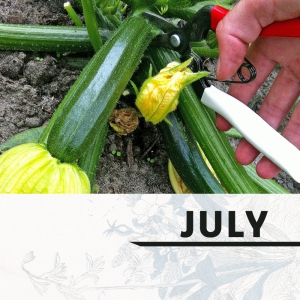
July is mainly a month for harvesting, less so for sowing and planting. You can put lettuce and endive in the ground, but many vegetable gardeners focus on harvesting. In the top 5 of this month, you can read how to harvest and process the home-grown vegetables and fruit.
1. Harvest broad beans
If you have sown or planted broad beans in the spring, they are now ready to be harvested. For weeks they have been small mini pods on the broad beans. They stayed small for a very long time, so you may have lost hope. Then all of a sudden the pods end with a growth spurt and are ready to be harvested! You can carefully pull the pods off the plant or cut them off. A harvest scissor with a curved tip is suitable for this job, the curved tip prevents you from accidentally damaging the stem of the broad bean. Pay attention to your hands: if you don’t want black fingers, wear gloves! The peels of broad beans contain a substance that dyes your hands black and it will not go away easily!
2. Picking peas
Also the peas are ready! Pulling the peas one by one from the plant works best and fastest. The amount of snow peas can be overwhelming at this time of the year, so after harvesting, you can blanch and freeze part of the harvest. What is sometimes done at upscale restaurants is to add fresh, young tops of the snow pea plant to, for example, a salad. Cut the top of the plant with a sharp pair of scissors and use them the same day. Tastes and looks great!
3. Harvest beets
Beets are often ready to be harvested in July. Choose the most beautiful specimens and carefully pull them out of the ground. The first beet can be harvested when they are as large as a golf ball. If you prefer larger beets, wait a while, but keep an eye on the plants! Beets don’t get any better when they grow larger than a tennis ball. After harvesting, you can twist or cut the leaves from the beet to make a delicious salad. The foliage will quickly become limp, so eat up quickly. Otherwise, toss it on the compost heap, then the little critters will also have a feast!
4. Courgette overload
If you have a single courgette plant in the garden, July will present you with an abundance of courgettes. They taste best small, so harvest them early. A courgette can grow into a huge fruit in a matter of days that is actually more decorative than tasty. In short, keep a close eye and harvest in time! The small fruits most likely will need to be cut off, but larger ones can be twisted until they pop off.
5. Berry party
Finally, next to the strawberries, the currants will be ready for the harvest. Delicious in yogurt or processed into juice or jam! The intense red betties hang in pretty clusters on the bush and these bunches can be carefully picked. The fruits are delicate, so treat them cautiously. Just like the peas, the surplus berries can be easily frozen. That way you can enjoy them the rest of the year!


